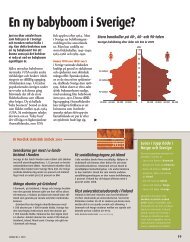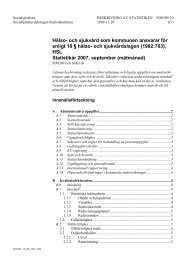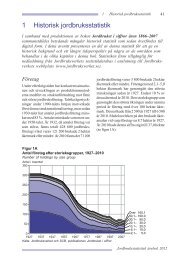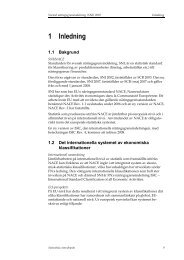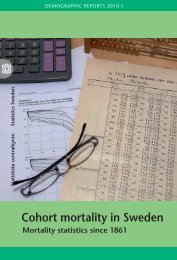Perspektiv på välfärden 2004 (pdf) - Statistiska centralbyrån
Perspektiv på välfärden 2004 (pdf) - Statistiska centralbyrån
Perspektiv på välfärden 2004 (pdf) - Statistiska centralbyrån
You also want an ePaper? Increase the reach of your titles
YUMPU automatically turns print PDFs into web optimized ePapers that Google loves.
table 4, (denoted with #) and reveal that students,<br />
quite expectedly, do not tend to be employed. It is<br />
also the case that the employed are less prone to<br />
have an unemployment history and that young<br />
people with higher education tend to have children<br />
to a lesser extent. Finally it is revealed that<br />
having children and nest leaving are positively<br />
correlated. Let us now move on to the core of the<br />
analysis.0<br />
Latent variables<br />
In table 5, the relationships between all the manifest<br />
variables related to the two first blocks of<br />
Figure 1 and the latent variables, i.e. income intercept,<br />
deprivation intercept, income slope and<br />
deprivation slope, are displayed. The parameters<br />
represent first the direct standardized regression,<br />
and when appropriate, the correlation coefficient.<br />
However, the direct effects only tell part of the<br />
story, as a substantial component of the impact in<br />
a complex causal model is indirect. Looking only<br />
at the direct effects will therefore erroneously lead<br />
us to believe that a number of variables are unimportant.<br />
Therefore the total effect (indirect + direct)<br />
is also displayed both as standardized and<br />
unstandardized coefficients.<br />
Income intercept<br />
As expected, the income intercept increases with<br />
age. The total effect is, due to an indirect impact,<br />
somewhat higher than the direct effect and the<br />
unstandardized coefficient reveals that income<br />
increases by approximately eight and a half thousand<br />
SEK every year. A more interesting result is<br />
the difference between women and men. There is<br />
a clear gender gap already at this early stage of<br />
the life course, and the total effect shows an annual<br />
income difference of almost 16,000 SEK.<br />
The small indirect effect of gender is attributable<br />
to women’s exposure to unemployment and early<br />
parenthood. The direct impact of class is relatively<br />
small, but reveals that white-collar origin<br />
(middle and high) is associated with a low income<br />
intercept. The total effects are considerably larger<br />
and amplify the differences between those with a<br />
blue-collar origin and those with a white-collar<br />
background. The indirect effect is mainly caused<br />
by the higher probability among those with whitecollar<br />
origin of studying and, hence, of not being<br />
employed. Educational attainment does not affect<br />
income intercept. Being a student does, unsurprisingly,<br />
have a negative effect on income intercept.<br />
The same holds for unemployment, especially<br />
long-term unemployment and parenthood, while<br />
employment naturally increases the income.<br />
Deprivation intercept<br />
In concordance with the result for income intercept,<br />
the intercept for deprivation decreases with<br />
Youth<br />
age. Gender does not directly affect deprivation<br />
intercept, but there is a substantial indirect effect<br />
showing that women are more prone to report<br />
economic difficulties. The indirect effect is mediated<br />
by young women’s higher probability of<br />
leaving the nest at early age, being a parent, being<br />
unemployed and receiving social assistance.<br />
Again it is revealed that the direct impact of class<br />
is minor, but that the indirect effect is substantial,<br />
as class affects almost every one of the manifest<br />
variables that are supposed to be intermediate to<br />
class and the latent variables. The important aspect<br />
to notice is that those with a middle range or<br />
higher white-collar origin not only have the lowest<br />
income intercept, they also have the lowest<br />
deprivation intercept. Hence, their income situation<br />
does not correspond with their experience of<br />
economic difficulties.<br />
The educational effect is somewhat harder to<br />
understand. The level of education, after primary<br />
school, does not seem to be particularly important<br />
even though there are some differences. The main<br />
gap is between those who only have a primary<br />
school education and the rest. A speculative interpretation<br />
would be to suggest that those who only<br />
have a primary school education are a selected<br />
group and that the mechanism leading to early<br />
drop out from the educational system is also connected<br />
to the probability of ending up in an economically<br />
difficult situation.<br />
The fact that st00udents score relatively low on<br />
deprivation intercept should be interpreted in the<br />
light of the negative effect of the interaction term<br />
between age and being a student. The interaction<br />
shows that the longer a person stays in the educational<br />
system, the greater her/his economic problems.<br />
Hence, there is a price to be paid for investment<br />
in human capital. Unemployment, nest<br />
leaving, parenthood and social assistance are all<br />
related to a high deprivation intercept. The last of<br />
these, social assistance, is worth an extra comment.<br />
It is not assumed that social assistance per<br />
se leads to economic difficulties, if anything the<br />
direction of causation should be the opposite.<br />
However, receiving assistance can also be interpreted<br />
as an indicator of an overall difficult situation,<br />
and from that 0perspective is it reasonable to<br />
construe assistance as an indicator of economic<br />
difficulties. It can finally be noted that income<br />
intercept correlates with deprivation intercept in<br />
the expected way, i.e., the higher the income, the<br />
less serious one's problems.<br />
Income slope<br />
The age effect is, as expected, minor and only<br />
indirect. The effect of gender on income slope is<br />
great, direct and important. Compared to men,<br />
women’s income development not only begins at<br />
a lower level (income intercept), it also grows<br />
75




